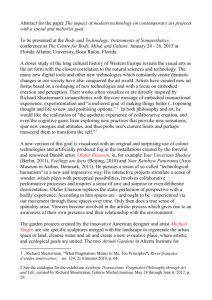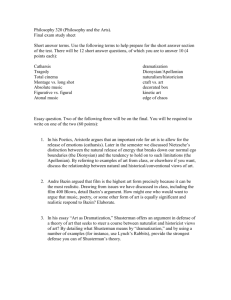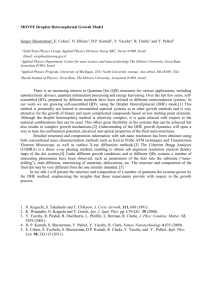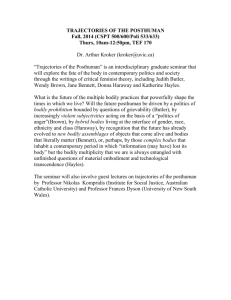Philosophy as an Art of Living
advertisement
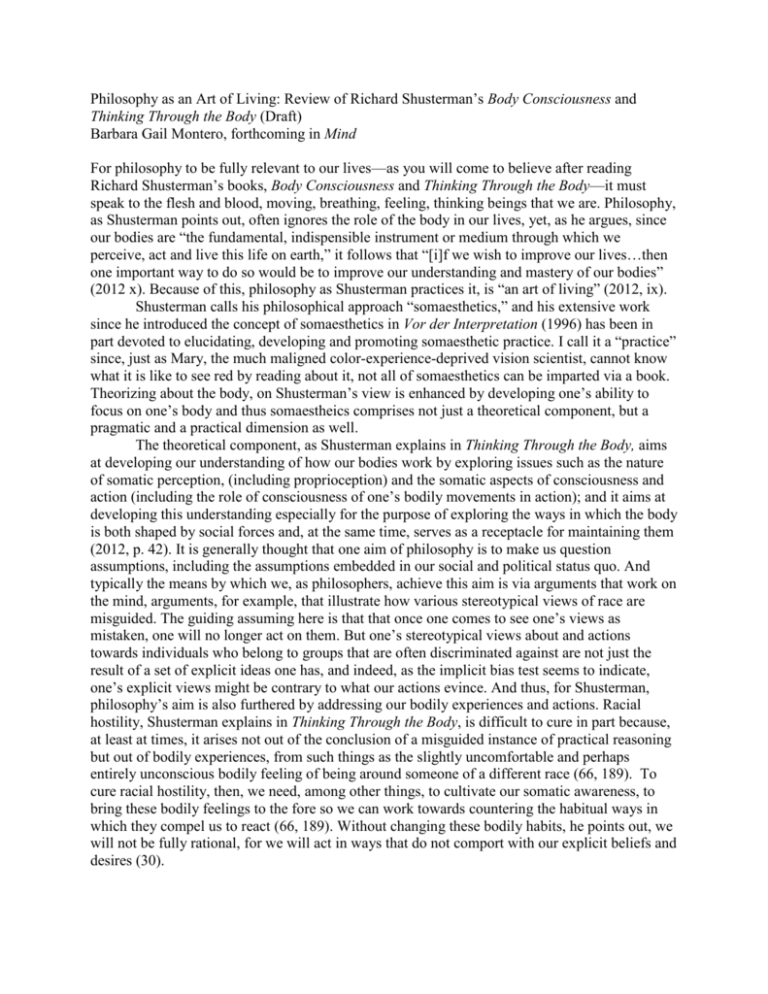
Philosophy as an Art of Living: Review of Richard Shusterman’s Body Consciousness and Thinking Through the Body (Draft) Barbara Gail Montero, forthcoming in Mind For philosophy to be fully relevant to our lives—as you will come to believe after reading Richard Shusterman’s books, Body Consciousness and Thinking Through the Body—it must speak to the flesh and blood, moving, breathing, feeling, thinking beings that we are. Philosophy, as Shusterman points out, often ignores the role of the body in our lives, yet, as he argues, since our bodies are “the fundamental, indispensible instrument or medium through which we perceive, act and live this life on earth,” it follows that “[i]f we wish to improve our lives…then one important way to do so would be to improve our understanding and mastery of our bodies” (2012 x). Because of this, philosophy as Shusterman practices it, is “an art of living” (2012, ix). Shusterman calls his philosophical approach “somaesthetics,” and his extensive work since he introduced the concept of somaesthetics in Vor der Interpretation (1996) has been in part devoted to elucidating, developing and promoting somaesthetic practice. I call it a “practice” since, just as Mary, the much maligned color-experience-deprived vision scientist, cannot know what it is like to see red by reading about it, not all of somaesthetics can be imparted via a book. Theorizing about the body, on Shusterman’s view is enhanced by developing one’s ability to focus on one’s body and thus somaestheics comprises not just a theoretical component, but a pragmatic and a practical dimension as well. The theoretical component, as Shusterman explains in Thinking Through the Body, aims at developing our understanding of how our bodies work by exploring issues such as the nature of somatic perception, (including proprioception) and the somatic aspects of consciousness and action (including the role of consciousness of one’s bodily movements in action); and it aims at developing this understanding especially for the purpose of exploring the ways in which the body is both shaped by social forces and, at the same time, serves as a receptacle for maintaining them (2012, p. 42). It is generally thought that one aim of philosophy is to make us question assumptions, including the assumptions embedded in our social and political status quo. And typically the means by which we, as philosophers, achieve this aim is via arguments that work on the mind, arguments, for example, that illustrate how various stereotypical views of race are misguided. The guiding assuming here is that that once one comes to see one’s views as mistaken, one will no longer act on them. But one’s stereotypical views about and actions towards individuals who belong to groups that are often discriminated against are not just the result of a set of explicit ideas one has, and indeed, as the implicit bias test seems to indicate, one’s explicit views might be contrary to what our actions evince. And thus, for Shusterman, philosophy’s aim is also furthered by addressing our bodily experiences and actions. Racial hostility, Shusterman explains in Thinking Through the Body, is difficult to cure in part because, at least at times, it arises not out of the conclusion of a misguided instance of practical reasoning but out of bodily experiences, from such things as the slightly uncomfortable and perhaps entirely unconscious bodily feeling of being around someone of a different race (66, 189). To cure racial hostility, then, we need, among other things, to cultivate our somatic awareness, to bring these bodily feelings to the fore so we can work towards countering the habitual ways in which they compel us to react (66, 189). Without changing these bodily habits, he points out, we will not be fully rational, for we will act in ways that do not comport with our explicit beliefs and desires (30). The pragmatic element of somaethetics, as Shusterman explains, analyses various methods aimed at improving our use of our bodies, such as yoga, meditation, dance, the erotic arts, massage, body building, as well as the Alexander Technique and the Feldenkrais Method. (The latter two are aimed at correcting faulty movement habits via increased bodily self-focus; Shusterman himself is a certified Feldenkrais instructor.) In one sense Susterman’s thoughts on these issues can be seen as various forms of “philosophy of’s”: philospohy of yoga, philosophy of dance and so on. But it is the focus on the bodily element of these endeavors, in particular the way in which they bring about heightened understanding of our bodies, that places them under the umbrella of somaesthetics. For example, whereas standard topics in philosophy of dance include, “what is dance?” “how are dance performances individuated?” and “what is the relationship between dance notation and choreography?”, Shusterman discusses the way dancers rely on conscious proprioception to inform them about their movements and how various practices can improve one’s ability to focus on one’s body. The former questions have relatively little to do with being embodied, the later points are inseparable from it. Besides its theoretical and pragmatic branches, somaesthetics, as Shusterman envisions it, also encompasses a practical component, which involves actually engaging in programs of disciplined, reflective corporeal practice aimed at somatic self-improvement. In other words, somaesthetics advocates that one ought to practice what one preaches. Although the Ancient Greeks intertwined philosophy and physical disciplines, and although various Eastern philosophical traditions have included bodily training, this is not common in the Western world today. This, Shusterman thinks, is a mistake, for such a separation of mind from body, on his view, leads to a separation of reason from action. Think back to Hume who advised us to rely on habit even when reason tells us to do otherwise. Reason, Hume argued, leads us to place no faith in conclusions arrived at via inductive reasoning, such as our conviction that the ground will not fall through when we walk on it. But rather than living our lives in accord with reason, he advocated that we should let habit take over and go ahead and walk out the door without a second thought. Habit, on Hume’s view, ought to be blind to the dictates of reason. Shusterman, in contrast, argues that we ought to correct our bodily habits so that they are more in line with our rational goals. While he does not think that we should hesitate before each step we take and check to see if the floor will hold (likely because he does not see this as the rational action to begin with), he promotes a variety of bodily practices—including the Feldenkraist Method— aimed at helping us to achieve our rational goals. The books under review are, of course, examples of the first two components of somaesthetics, though in chapter 5 of Thinking Through the Body, “Somaesthetics in the Philosophy Classroom: a Practical Approach,” Shusterman provides an example of practical somaesthetics by illustrating how he leads students through a guided “body scan,” a process by which one is directed to focus—via proprioception and the tactile sensations of being in contact with the floor or a chair—on ones bodily sensations, on, for example the weight of one’s legs as they are extended along the floor or on whether one arm feels more relaxed than the other. The body-scan, though not at all part of what we would normally think of as philosophy, is, he argues, aimed at what he and the Ancient Greeks saw as the first step in rational action, and that is, self-knowledge. However, rather than developing one’s knowledge of what the Ancient Greeks saw as the self—that is, the disembodied mind—the form of self-knowledge it encourages is somatic. “Philosophy,” Shusterman points out in Thinking Through the Body, “has traditionally linked its central goal of self-knowledge with the goal of self-cultivation or selfcare, on the grounds that we can care for something better if we know more about it; that to effectively cultivate or improve the self and its behavior we need to know those aspects of the self and behavior we wish to improve or cultivate” (p. 113). The body scan, as Shusterman conceives of it, helps us to become better aware of our bodily self, which is the source of all our behavior. This practical component of somaesthetics, Shusterman points out is beneficial to our bodily health and, as I mentioned, to changing ingrained habits that embody prejudices. Moreover, as Shusterman illustrates, it also has an aesthetic component, since, as he sees it, “somaesthetics can help not only explain but also improve aesthetic experience” (2012, p. 65). It does this in a variety of ways. Some of these are rather obvious. For example, artists, like everyone, use their bodies, and so somatic training, including training that is aimed at developing a heightened somatic awareness can help them to use their bodies better; and, as Shusterman points out, artists frequently do work with Feldenkraist or Alexander practitioners. Having better artists leads, of course, to better aesthetic experiences. Moreover, for the appreciator of art, if you have poor posture you may experience fatigue or discomfort when sitting in a theater for an extended time or standing in front of a great painting and this will distract you. True enough, but, again, no surprise. However, his central point is one that might not be widely recognized and that is that somatic self care can also help “intensify attention,” and this is because the practice of the body-scan is aimed precisely at heightening awareness (2012, p.165). The audience members at a dance performance who have engaged in various somaesthetic practices, then, pay attention better not only because they are able to sit more comfortably, but also because these practices are themselves are exercises in attention, and thus better enable audience members to focus on art. Beyond this, I would emphasize that because somatic practices such as yoga, dance, Alexander technique and the Feldenkriest method are exercises specifically in bodily attention, they can help us to focus specifically on bodies (the bodily movements of dancers, for example) and notice the bodily aspects of various other arts: the bodily movements the painter must have made painter or the way the pianist’s fingers much have stretched in order to create a certain musical effect. I think of this as a kind of “kinesthetic sympathy,” that is, the experience, upon watching someone else move, of moving without actually moving your body. This type of experience, I have argued, may be rightly called aesthetic since it allows us to experience (somatically) a dancer’s (for example) grace, line, power and precision. Both books are written in Shusterman’s lucid and engaging style. Thinking Through the Body is a collection of (for the most part) previously published essays, which have been revised (sometimes extensively so) and woven together to form a continuous whole. There are essays on a broad range of topics, including muscle memory, photography, the ars erotica of Asia, and the role of the body in cultural polotics. In contrast, Body Consciousness critically analyses six philosophers—Maurice Merleau-Ponty, Simone de Beauvoir, Michel Foucault, Ludwig Wittgenstein, William James and John Dewy—with respect to their theorizing about the body. This book will bring new insights to those who are already steeped in the philosophers he discusses, but can also serve to entice the uninitiated. I think that Shusterman’s books will be embraced by scholars in a wide range of disciplines. As for me, since I write about the importance of thought and awareness of one’s movements in action, I was especially interested in Shusterman’s take on this. As he points out, it is often assumed that “any sustained focus on bodily feelings is both unnecessary and counterproductive for effective thought and action,” and that attention “must instead be directed exclusively outward for out engagement with the external world.” However, he argues that although everyday actions ought to proceed without thought “until they prove problematic in experience,” when this happens, “the unreflective action or habit must be brought into conscious critical reflection (if only for a limited time)” (pp. 212, 63). I might even go a bit further and claim that even if such actions are not problematic, it may be worthwhile to reflect on them in order to improve them before the problem occurs, or to make efficient movements even more efficient. Additionally, the process of critically reflecting on your movements can be enjoyable in and of itself; thus, such reflection, even if it interferes with movement, might be recommended for the sheer delight of it. Beyond this, Shusterman aims to dissolve the simple dichotomy between the internal and the external, for as he sees it to focus acutely on one’s body is to experience it as part of the environment; to feel oneself moving is in part to experience oneself moving through the environment, to feel oneself sitting or standing is in part to feel oneself sitting or standing on something. “Such lessons of somatic self-conscious[ness]” he explains, rather than distancing us from the external world “eventually point toward the vision of an essentially situated, relational, and symbiotic self” (2008, p. 8).. Philosophers are concerned with the good life. And although most would say that one does not live a good life by pleasure alone, it is hard to deny that the good life will encompass some pleasurable activities. Thus it would seem that understanding the nature of pleasure should be a central philosophical topic. However, Shusterman points out, although contemporary philosophers spend a great deal of time thinking about pain, rarely is pleasure a topic of concern. Somaesthetics addresses bodily pleasure by understanding its nature, by investigating various means to increase it and, finally, by engaging in activities that increase it. Shusterman’s books also increase pleasure in another way, for they are a pleasure to read. To be sure, this sort of pleasure is not of the bodily kind, and it also may not live up to what Henry Sambrooke Leigh spoke of as “the rapturous, wild, and ineffable pleasure of drinking at somebody else's expense.” Nonetheless, Body Consciousness and Thinking Through the Body are extremely enjoyable books, and I recommend them to anyone, philosopher and nonphilosopher alike, who is interested in the experience of embodiment and role that bodily awareness plays in our lives.
